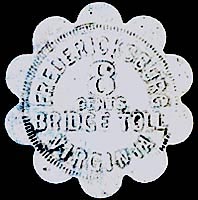By Roy Butler
Since the body of water known as the Rappahannock River separated two important areas of commerce and trade, it had, of course, to be crossed constantly. The Indians had their canoes and the early settlers had their boats and ferries. The first bridge was built about 1800 and was referred to as Scott's Bridge. It spanned the river at precisely the same location as the existing bridge from Chatham to Fredericksburg.
Long before the first bridge, the Old Indian Trail from the Northern Neck to the Fredericksburg and Falmouth waterfront areas became the Great Road or King's Highway. Built by Robert "King" Carter, it was over one hundred miles long and played an important role in area commerce and trade. Prior to 1800 and the building of Scott's Bridge, those traveling east or west had to traverse the Rappahannock by boat or ferry.
By the mid-nineteenth century, the bridge had a new name. The 1852 City Directory mentions a business located at the foot of Commerce Street near Coulter's Bridge. According to one source, the bridge washed out during the early nineteenth century and apparently it changed hands and names sometime during this period.
During the Civil War, the bridge was detonated by the Confederate forces, and the Old Steel Bridge replaced it. Also known for many years as "The Toll Bridge," it was still active as such during the early 1920s as the accompanying photograph suggests.
The illustrated eight-cent token was quite a lot of money to pay as a bridge toll at a time in our history when fifty cents to two dollars per day was considered a living wage. A daily commuter may have kept his row boat anchored along the shore or perhaps, as we do today, he may have joined a "carpool," assuming that the token was per vehicle rather than per individual. For that matter, the toll may not have applied to pedestrians.
At any rate, it did not apply to my brother and me during the 1920s and early 1930s as we scampered across the bridge in the excited execution of a simple act of free enterprise -- catching an unwary snapping turtle sunning on the sandbar. We took the hissing, snapping creature to the Fredericksburg Fish & Oyster Market at the northeast corner of Sophia and William Streets at the bridge. The market was then operated by Mr. Lloyd O. Forbush, well known in the area for many years.
The twenty-five to fifty cents that the catch yielded was spent after great deliberation. Generally, a Dr. Bond's or Feuerherd's succulent soda for five cents initiated our spending spree and a Hoot Gibson or Tom Mix movie at the old Pitts Leader Theatre, admission ten cents, pretty much depleted our purse. But then there was always another hike across the (by then) Free Bridge in pursuit of another hapless turtle. In those days, they were plentiful, and the Fredericksburg Fish & Oyster Market welcomed them.
Mr. Forbush operated the market from 1928 until his death in 1942, according to his son, Warren Forbush of Fredericksburg. It thrived during the "Great Depression," when jobless people could afford an inexpensive seafood diet as well as find a waiting wholesale market for their own catches. The market kept many pockets jingling with silver during a trying period of our local history and to this day it is still a pleasant reminder of our town's early history.
"The Free Bridge," as it was called after the toll was discontinued, was also an important part of our history. This steel bridge was destroyed by the flood of 1937, and its replacement has been generally referred to as the Chatham Bridge. Let us hope that with the current repairs it will last for many years and that there will be no recurrence of either the tolls or the floods.
This article originally appeared in the Fredericksburg Times and was reprinted in the compilation of Mr. Butler's works, Fredericksburg Underground (pp. 131-134), which is available in the Virginiana Room of the Headquarters library.


